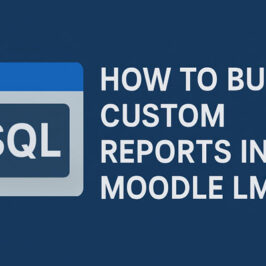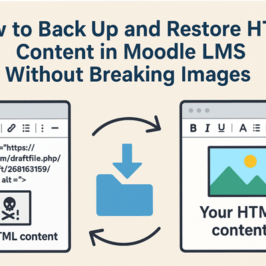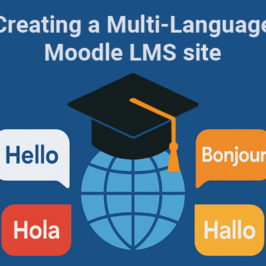Moodle LMS service providers, organizations and independent developers are racing to integrate artificial intelligence into their plugins and services. From chatbots that assist educators in creating course content, tutoring students, and creating custom reports for administrators and management, AI-powered SaaS solutions for e-learning are transforming how learning management systems operate. But beneath the surface lies a complex web of challenges.
The promise of AI is undeniable: increased efficiency, automated decision-making, and enhanced user experiences. The reality of building and maintaining AI-powered SaaS products, however, is far more nuanced. If you're considering launching an AI SaaS solution for Moodle LMS, here are some critical considerations that often catch entrepreneurs and development teams off guard.
Disclaimer: This article provides general information and considerations for AI SaaS development. It is not legal advice. Please consult with qualified legal professionals for specific legal guidance related to your AI product or service.
1. Accountability and Liability: When AI Gets It Wrong
AI hallucinations and inaccuracies present one of the most significant challenges for SaaS providers. Large language models can generate plausible but incorrect or misleading course content and quizzes in Moodle LMS, creating complex liability questions. Who's responsible when the AI makes a mistake: the vendor, the instructional designer/teacher, or the AI service provider?
This becomes especially critical when AI outputs influence decisions related to assessments, credentials, or certifications in fields like healthcare, law, or finance. In these contexts, even a single error can have serious consequences, potentially affecting learners' careers and exposing institutions to legal or regulatory scrutiny.
The challenge extends to user experience design: How do you balance useful disclaimers with a product that inspires user confidence? Should disclaimers appear at installation time or at the point of usage? Getting this balance wrong can either create liability exposure or undermine user trust.
Similar responsibility questions arise around system performance: Who bears responsibility for performance issues—your organization, the user, or the underlying AI service provider? This distinction affects both your service level agreements and your relationship with customers.
2. Ownership & Intellectual Property Rights
The legal landscape surrounding AI-generated content remains murky. Users often assume they own the output from your AI tool, but copyright eligibility for AI-generated content is still being debated in courts worldwide.
Additional IP concerns include training data rights. If your AI was trained on copyrighted material, there may be downstream implications for your service. When users incorporate your AI output into their work, questions arise about who owns the resulting derivative content. These uncertainties can create legal risks that are difficult to quantify and manage.
This becomes particularly complex when AI generates content that becomes part of institutional curricula, corporate training materials, or organizational assessments.
3. Cost and Resource Management
AI services such as OpenAI, Anthropic, and Google operate on fundamentally different cost structures than traditional software. Usage-based pricing models (per token or API call) versus tiered subscriptions each present unique challenges.
High-volume users can drive up operating costs disproportionately, potentially making certain customer segments unprofitable. Real-time applications face additional complexity as increased load can impact latency and throughput, requiring careful infrastructure scaling.
4. Guardrails and Misuse Prevention
AI systems are vulnerable to prompt injection attacks and jailbreaking attempts, where users try to bypass safety filters or generate harmful content. Your terms of service may prohibit hate speech, fake news, or impersonation, but enforcing these rules technically is challenging.
Beyond harmful content, you'll also face the challenge of unrelated usage—users employing your AI tool for purposes outside its intended scope. A tool designed for generating quiz questions might be used for creating policy documents, lesson plans, research summaries, or even vacation planning. This scope creep can drive up costs unexpectedly, create poor user experiences in domains where your AI wasn't optimized, and potentially expose you to liability if users rely on AI advice in areas it wasn't designed to handle.
Content moderation becomes a real-time technical and ethical challenge. You may need to scan or moderate AI outputs as they're generated, requiring sophisticated systems and clear policies about what constitutes acceptable use.
5. Privacy and Data Protection
User data privacy takes on new dimensions with AI services. You must ensure that the underlying language model doesn't leak or memorize sensitive user input, while also complying with regulations like PIPEDA/CPPA, GDPR, CCPA, and HIPAA.
Student data protection becomes paramount in educational settings. FERPA compliance in the US requires strict controls over educational records, while similar regulations worldwide impose additional constraints on how student information can be processed and shared.
Data retention policies become more complex when dealing with AI services. How long is user data stored? How is it used for fine-tuning or analytics? These policies may vary depending on your AI service provider and your specific application, requiring careful coordination and transparency.
6. Model Drift and Maintenance
As AI models are updated, their outputs can change over time, potentially disrupting user expectations or established workflows. Should you offer user-configurable options like temperature settings? Do you need model versioning or even frozen models per customer?
Even with identical model versions, asking the same question twice can yield different results. This inherent variability requires careful bias monitoring and continuous testing to ensure outputs remain fair and non-discriminatory across all user organizations.
7. Security Considerations
Beyond standard application security, AI services face unique threats. Prompt injection attacks (as mentioned in guardrails) can cause models to behave unexpectedly, while data leakage vulnerabilities might allow users to extract training data or internal knowledge from the underlying AI model.
API security becomes more complex when dealing with AI services, requiring robust measures to prevent abuse or unauthorized access to your backend systems.
8. Explainability, Trust, and Content Integrity
Large language models are essentially black-box systems, making it difficult to explain how they arrive at specific outputs. Enterprise customers often require explanations or justifications for AI decisions, along with comprehensive audit logs for traceability.
Building trust with users requires transparency about limitations and decision-making processes, even when the underlying AI system is opaque. This transparency becomes particularly important when organizations use AI-generated content for training materials, compliance documentation, or decision-making processes where accuracy and accountability are paramount.
Organizations need clear policies about disclosure and appropriate use of AI-generated content across different contexts. Different sectors face unique challenges: educational institutions must navigate academic integrity policies, corporations need to ensure training content meets compliance standards, government agencies require adherence to regulatory guidelines, and non-profits must balance cost-effectiveness with quality assurance.
Beyond integrity concerns, there's the fundamental question of organizational effectiveness: Does your AI tool actually improve learning outcomes and training effectiveness? Organizations increasingly demand evidence that AI integration enhances rather than hinders their learning and development objectives.
9. Localization and Accessibility
AI behavior varies significantly across languages, potentially creating inconsistent user experiences in global markets. Ensuring compliance with accessibility standards like ADA, WCAG, and AODA adds another layer of complexity to AI-powered interfaces.
Organizations across all sectors must ensure equal access to learning opportunities for users with disabilities, making accessibility compliance a critical consideration.
10. Regulatory Landscape
AI regulations are rapidly evolving, from the EU AI Act to various US state and federal initiatives. Industry-specific rules in medical, legal, or financial domains create additional compliance requirements that vary by jurisdiction and use case.
Organizations often operate under additional regulatory frameworks that govern how technology can be used in their environments, adding layers of compliance requirements to consider.
11. Integration Complexity
Clients may demand personalized model behavior through custom fine-tuning or plugins, significantly complicating deployment and maintenance. Each customization creates a unique support burden and potential point of failure.
Moodle LMS's plugin architecture adds another layer of complexity, as your AI solution must integrate seamlessly with existing workflows and third-party tools.
12. User Training and Support
AI tools must serve diverse user bases effectively across businesses, non-profits, government agencies, and educational institutions. This creates significant training challenges as you need to help users understand how to use AI tools effectively within their specific organizational contexts.
This creates ongoing onboarding challenges and often results in increased customer support interactions as users learn to work with AI systems effectively. The challenge is compounded by varying levels of technical literacy among staff across different sectors.
Conclusion: Success Lies in Preparation
Building a successful AI SaaS solution for Moodle LMS requires more than just integrating the latest language model into your product. The companies that thrive will be those that proactively address these challenges rather than treating them as afterthoughts. Start by clearly defining your liability boundaries, establishing robust content moderation systems, and investing in comprehensive privacy and security measures from day one. Most importantly, maintain transparency with your users about your AI's capabilities and limitations.
The AI market for organizational learning represents an enormous opportunity, but success demands careful planning across legal, technical, and operational dimensions. The question isn't whether AI will transform organizational learning—it's whether you'll be ready when it does.
Hope you found this information useful.
Michael Milette







Add a comment: